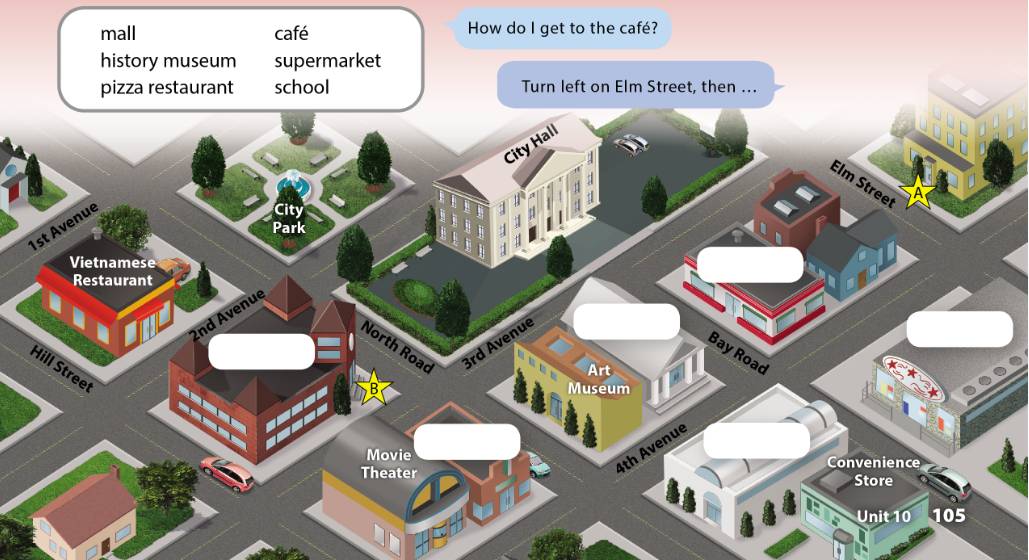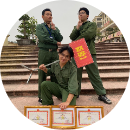E. Work with a partner. Ask and answer questions to make your partner's family tree. Look at Lisa’s family tree on page 133 to help you.

Những câu hỏi liên quan
4. Look at the paragraph.Complete the parts in blue with your ideas. Then work in pairs. Ask questions ( a maximum of twenty) to find the information in your partners paragraph. You can only answer Yes, I did or No, I didnt.(Nhìn vào đoạn văn. Hoàn thành các phần bằng màu xanh với ý tưởng của bạn. Sau đó làm việc theo cặp. Đặt câu hỏi (tối đa là hai mươi câu) để tìm thông tin trong đoạn văn của đối tác của bạn. Bạn chỉ có thể trả lời Có, tôi đã làm hoặc Không, tôi đã không.)Last week I went to...
Đọc tiếp
4. Look at the paragraph.Complete the parts in blue with your ideas. Then work in pairs. Ask questions ( a maximum of twenty) to find the information in your partner's paragraph. You can only answer " Yes, I did" or " No, I didn't".
(Nhìn vào đoạn văn. Hoàn thành các phần bằng màu xanh với ý tưởng của bạn. Sau đó làm việc theo cặp. Đặt câu hỏi (tối đa là hai mươi câu) để tìm thông tin trong đoạn văn của đối tác của bạn. Bạn chỉ có thể trả lời "Có, tôi đã làm" hoặc "Không, tôi đã không".)
Last week I went to (a famous city) and went to the cinema with (a famous actor/ actress). Then we had dinner with (a famous sports star) and we talked and danced for (two/ three/ four) hours.
Last week I went to Paris and went to the cinema with Angela Jolie. Then we had dinner with Lionel Messi and we talked and danced for four hours.
(Tuần trước, tôi đã đến Paris và đi xem phim với Angela Jolie. Sau đó, chúng tôi ăn tối với Lionel Messi và nói chuyện và khiêu vũ khoảng bốn giờ.)
A: Was Le Quy Don a Vietnamese scholar?
(Lê Quý Đôn có phải là nhà nho Việt Nam không?)
B: Yes, he was.
(Vâng, đúng rồi.)
A: Did he live in the 19th century.
(Có phải ông ấy sống ở thế kỷ 19 không.)
Student 2: No, he didn’t.
(Không, không phải.)
Student 1: Was he a poet, a scholar, and a government official?
(Ông ấy có phải là một nhà thơ, một học giả và một quan chức chính phủ không?)
Student 2: Yes, he was.
(Vâng, đúng rồi.)
Student 1: Did Le Quy Don go to China as an ambassador in 460?
(Lê Quý Đôn đi sứ sang Trung Quốc năm 460?)
Student 2: No, he didn’t.
(Không, không phải.)
Student 1: Was he the principal of the National University situated in the Văn Miếu in Hà Nội?
(Ông ấy có phải là hiệu trưởng trường Đại học Quốc gia ở Văn Miếu, Hà Nội không?)
Student 2: Yes, he was.
(Vâng, đúng rồi.)
Student 1: Did he have many works of the old Vietnamese literature?
(Ông có bao nhiêu tác phẩm thuộc văn học cổ Việt Nam?)
Student 2: Yes, he did.
(Vâng, đúng rồi.)
Student 1: Did he pass away in 1884 when he was 68 years old.
(Có phải ông ấy đã qua đời vào năm 1884 khi ông ấy 68 tuổi.)
Student 2: No, he didn’t.
(Không, không phải.)
Đúng 0
Bình luận (0)
Find the places. Work with a partner. Student A: Look at the map below. Student B: Look on page 137. Take turns to ask your partner for directions to each place and lable them on your map. Then compare and check your map.

How do I get to the mall?
Go down straight North road and turn left on 3rd Avenue. It is on your left.
How do I get to histoy museum?
Go down straight North road and turn left on 4th Avenue. It is on your left and next to Art museum.
How can I get to pizza restaurant?
Go down straight North road and turn left on 4th Avenue. Then, turn left on Bay Road. It is on your right
Đúng 0
Bình luận (0)
Hướng dẫn dịch
Làm cách nào để đến trung tâm mua sắm?
Đi thẳng xuống đường Bắc và rẽ trái trên Đại lộ 3. Nó ở bên trái của bạn.
Làm cách nào để đến bảo tàng lịch sử?
Đi thẳng xuống đường Bắc và rẽ trái trên Đại lộ 4. Nó ở bên trái của bạn và bên cạnh bảo tàng nghệ thuật.
Làm thế nào đến nhà hàng pizza?
Đi thẳng xuống đường Bắc và rẽ trái trên Đại lộ 4. Sau đó, rẽ trái trên Đường Bay. Nó ở bên phải của bạn
Đúng 0
Bình luận (0)
Read the following passage and mark A, B, C, or D to indicate the correct answer to each of the blanks.EXAM ADVICEIn Part Three of the Speaking Section you work together with a partner. You have to do a (43)______ task which usually lasts about 3 minutes. One possible task is “problem solving”, which means you have to look at some (44)______information and then discuss the problem with your partner. You may be shown photos, drawings, diagrams, maps, plans, advertisements or computer graphics and...
Đọc tiếp
Read the following passage and mark A, B, C, or D to indicate the correct answer to each of the blanks.
EXAM ADVICE
In Part Three of the Speaking Section you work together with a partner. You have to do a (43)______ task which usually lasts about 3 minutes. One possible task is “problem solving”, which means you have to look at some (44)______information and then discuss the problem with your partner. You may be shown photos, drawings, diagrams, maps, plans, advertisements or computer graphics and it is (56) ______ that you study them carefully. If necessary, check you know exactly what to do by politely asking the examiner to repeat the instruction or make them clearer.
While you are doing the task, the examiner will probably say very little and you should ask your partner questions and make (46) ______ if he or she is not saying much. If either of you have any real difficulties, the examiner may decide to step in and help. Normally, however, you will find plenty to say, which helps the assessor to give you a fair mark. This mark depends on your success in doing the task by competing with your partner, which includes taking (47) ______ in giving opinions and replying appropriately, although in the end it may be possible to “agree to disagree”.
Điền vào số (44)
A. optical
B. visual
C. noticeable
D. obvious
Đáp án B
Giải nghĩa: visual information: thông tin thị giác.
Các đáp án còn lại:
A. optical (adj): thuộc về mắt.
C. noticable (adj): đáng chú ý.
D. obvious (adj): rõ ràng.
Đúng 0
Bình luận (0)
Read the following passage and mark A, B, C, or D to indicate the correct answer to each of the blanks.EXAM ADVICEIn Part Three of the Speaking Section you work together with a partner. You have to do a (43)______ task which usually lasts about 3 minutes. One possible task is “problem solving”, which means you have to look at some (44)______information and then discuss the problem with your partner. You may be shown photos, drawings, diagrams, maps, plans, advertisements or computer graphics and...
Đọc tiếp
Read the following passage and mark A, B, C, or D to indicate the correct answer to each of the blanks.
EXAM ADVICE
In Part Three of the Speaking Section you work together with a partner. You have to do a (43)______ task which usually lasts about 3 minutes. One possible task is “problem solving”, which means you have to look at some (44)______information and then discuss the problem with your partner. You may be shown photos, drawings, diagrams, maps, plans, advertisements or computer graphics and it is (56) ______ that you study them carefully. If necessary, check you know exactly what to do by politely asking the examiner to repeat the instruction or make them clearer.
While you are doing the task, the examiner will probably say very little and you should ask your partner questions and make (46) ______ if he or she is not saying much. If either of you have any real difficulties, the examiner may decide to step in and help. Normally, however, you will find plenty to say, which helps the assessor to give you a fair mark. This mark depends on your success in doing the task by competing with your partner, which includes taking (47) ______ in giving opinions and replying appropriately, although in the end it may be possible to “agree to disagree”.
Điền vào số (43)
A. lonely
B. single
C. unique
D. once
Đáp án B
(to) do a single task: làm 1 nhiệm vụ.
Các đáp án còn lại:
A. lonely (adj): cô đơn.
C. unique (adj): độc đáo.
D. once: 1 lần.
Đúng 0
Bình luận (0)
Read the following passage and mark A, B, C, or D to indicate the correct answer to each of the blanks.EXAM ADVICEIn Part Three of the Speaking Section you work together with a partner. You have to do a (43)______ task which usually lasts about 3 minutes. One possible task is “problem solving”, which means you have to look at some (44)______information and then discuss the problem with your partner. You may be shown photos, drawings, diagrams, maps, plans, advertisements or computer graphics and...
Đọc tiếp
Read the following passage and mark A, B, C, or D to indicate the correct answer to each of the blanks.
EXAM ADVICE
In Part Three of the Speaking Section you work together with a partner. You have to do a (43)______ task which usually lasts about 3 minutes. One possible task is “problem solving”, which means you have to look at some (44)______information and then discuss the problem with your partner. You may be shown photos, drawings, diagrams, maps, plans, advertisements or computer graphics and it is (56) ______ that you study them carefully. If necessary, check you know exactly what to do by politely asking the examiner to repeat the instruction or make them clearer.
While you are doing the task, the examiner will probably say very little and you should ask your partner questions and make (46) ______ if he or she is not saying much. If either of you have any real difficulties, the examiner may decide to step in and help. Normally, however, you will find plenty to say, which helps the assessor to give you a fair mark. This mark depends on your success in doing the task by competing with your partner, which includes taking (47) ______ in giving opinions and replying appropriately, although in the end it may be possible to “agree to disagree”.
Điền vào số (47)
A. changes
B. sides
C. turns
D. sentences
Đáp án C
Giải nghĩa: (to) take turns in V-ing: làm gì đó theo thứ tự.
Các đáp án còn lại:
A. change (n): sự thay đổi.
B. side (n): bên, góc, mạn sườn,…
D. sentence (n): câu văn, lời tuyên án,…
Đúng 0
Bình luận (0)
Read the following passage and mark A, B, C, or D to indicate the correct answer to each of the blanks.EXAM ADVICEIn Part Three of the Speaking Section you work together with a partner. You have to do a (43)______ task which usually lasts about 3 minutes. One possible task is “problem solving”, which means you have to look at some (44)______information and then discuss the problem with your partner. You may be shown photos, drawings, diagrams, maps, plans, advertisements or computer graphics and...
Đọc tiếp
Read the following passage and mark A, B, C, or D to indicate the correct answer to each of the blanks.
EXAM ADVICE
In Part Three of the Speaking Section you work together with a partner. You have to do a (43)______ task which usually lasts about 3 minutes. One possible task is “problem solving”, which means you have to look at some (44)______information and then discuss the problem with your partner. You may be shown photos, drawings, diagrams, maps, plans, advertisements or computer graphics and it is (56) ______ that you study them carefully. If necessary, check you know exactly what to do by politely asking the examiner to repeat the instruction or make them clearer.
While you are doing the task, the examiner will probably say very little and you should ask your partner questions and make (46) ______ if he or she is not saying much. If either of you have any real difficulties, the examiner may decide to step in and help. Normally, however, you will find plenty to say, which helps the assessor to give you a fair mark. This mark depends on your success in doing the task by competing with your partner, which includes taking (47) ______ in giving opinions and replying appropriately, although in the end it may be possible to “agree to disagree”.
Điền vào số (45)
A. essential
B. needed
C. helpful
D. successful
Đáp án A
Động từ phía sau không chia => Câu giả định: It tobe + essential + that + S V-inf.
Các đáp án còn lại:
B. needed (V-ed): cần.
C. helpful (adj): hữu ích.
D. successful (adj): thành công
Đúng 0
Bình luận (0)
Read the following passage and mark A, B, C, or D to indicate the correct answer to each of the blanks.EXAM ADVICEIn Part Three of the Speaking Section you work together with a partner. You have to do a (43)______ task which usually lasts about 3 minutes. One possible task is “problem solving”, which means you have to look at some (44)______information and then discuss the problem with your partner. You may be shown photos, drawings, diagrams, maps, plans, advertisements or computer graphics and...
Đọc tiếp
Read the following passage and mark A, B, C, or D to indicate the correct answer to each of the blanks.
EXAM ADVICE
In Part Three of the Speaking Section you work together with a partner. You have to do a (43)______ task which usually lasts about 3 minutes. One possible task is “problem solving”, which means you have to look at some (44)______information and then discuss the problem with your partner. You may be shown photos, drawings, diagrams, maps, plans, advertisements or computer graphics and it is (56) ______ that you study them carefully. If necessary, check you know exactly what to do by politely asking the examiner to repeat the instruction or make them clearer.
While you are doing the task, the examiner will probably say very little and you should ask your partner questions and make (46) ______ if he or she is not saying much. If either of you have any real difficulties, the examiner may decide to step in and help. Normally, however, you will find plenty to say, which helps the assessor to give you a fair mark. This mark depends on your success in doing the task by competing with your partner, which includes taking (47) ______ in giving opinions and replying appropriately, although in the end it may be possible to “agree to disagree”.
Điền vào số (46)
A. speeches
B. statements
C. ideas
D. suggestions
Đáp án D
Giải nghĩa: (to) make suggestions: đề xuất, đưa ra lời đề nghị.
Các đáp án còn lại:
A. speech (n): bài phát biểu.
B. idea (n): ý tưởng.
C. statement (n): câu văn, bài phát biểu.
Đúng 0
Bình luận (0)
Help us Save the World!(Hãy giúp chúng tôi cứu lấy Trái Đất!)a. You and your friend want to help a charity. Student B, turn to page 123 File 7. Work in pairs. Student A, answer Student Bs questions. Swap roles. Ask Student B about Earthwatch. Make notes. Ask your partner to repeat some information.(Em và bạn muốn giúp một tổ chức từ thiện. Học sinh A, chuyển đến trang 123 File 7. Làm việc theo cặp. Học sinh A, trả lời những câu hỏi của học sinh B. Đổi vai. Hỏi học sinh B về Earthwatch. Ghi chú l...
Đọc tiếp
Help us Save the World!
(Hãy giúp chúng tôi cứu lấy Trái Đất!)
a. You and your friend want to help a charity. Student B, turn to page 123 File 7. Work in pairs. Student A, answer Student B's questions. Swap roles. Ask Student B about Earthwatch. Make notes. Ask your partner to repeat some information.
(Em và bạn muốn giúp một tổ chức từ thiện. Học sinh A, chuyển đến trang 123 File 7. Làm việc theo cặp. Học sinh A, trả lời những câu hỏi của học sinh B. Đổi vai. Hỏi học sinh B về Earthwatch. Ghi chú lại. Yêu cầu bạn em lặp lại một số thông tin.)
What does Earthwatch do? (Earthwatch làm gì?)
Where do they work? (Họ làm việc ở đâu?)
How can I help? (Tôi có thể giúp như thế nào?)
| Trash Hero World |
What they do (Họ làm gì) | - plan cleanups (lên kế hoạch dọn dẹp) - help recycle trash (giúp tái chế rác) |
Where they work (Họ làm việc ở đâu) | Southeast Asia, Australia, Europe (Đông Nam Á, châu Úc, châu Âu) |
How to help (Giúp bằng cách nào) | - donate money (quyên góp tiền) - start a cleanup (bắt đầu quét dọn) |
A: What does Trash Hero World do?
(Trash Hero World làm gì?)
B: They plan cleanups and help recycle trash.
(Họ lên kế hoạch dọn dẹp và giúp tái chế rác.)
A: Where do they work?
(Họ làm việc ở đâu?)
B: They work in Southeast Asia, Australia, Europe.
(Họ làm việc ở Đông Nam Á, Úc, Châu Âu.)
A: How can I help?
(Tôi có thể giúp bằng cách nào?)
B: You can donate money and start a cleanup.
(Bạn có thể quyên góp tiền và bắt đầu dọn dẹp.)
Đúng 0
Bình luận (0)
USE IT! Work with a partner. Ask and answer questions about adventure activities. Use the ideas below.
Do you like the look of …?
Would you like to try …?
Have you ever tried …?
What do you think of …?
Tham khảo
Q: Do you like the look of the Everest Mountain?
A: Of course, I do. The appearance of Mount Everest changes depending on the time of day and the weather conditions. I like it during the sunrise and sunset, the colors of the surrounding landscape reflect off of the snow and create a beautiful orange-pink glow. It’s magnificent.
Q: Would you like to try zip-lining?
A: Yes, zip-lining is a thrilling adventure activity that involves sliding down a cable while attached to a harness. It can be a great way for me to experience stunning views.
Q: Have you ever tried rock climbing?
A: No, I haven’t. Rock climbing is a challenging adventure activity that involves scaling up a natural or artificial rock surface using special equipment. It requires strength, endurance, and mental focus. Therefore, it doesn’t suit me, I think.
Q: What do you think of skydiving?
A: Skydiving is a thrilling adventure activity that involves jumping out of an airplane at high altitude and freefalling before deploying a parachute to land safely on the ground. It can be an unforgettable experience for those who enjoy extreme sports and want to overcome their fears. However, it's not without risk and requires proper training and safety precautions.
Đúng 1
Bình luận (0)









